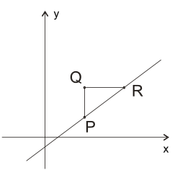BTGmoderatorDC wrote:
In the figure above, segments PQ and QR are each parallel to one of the coordinate axes. What is the ratio of the length of QR to PQ?
(1) The slope of the line that passes through points P and R is 0.75.
(2) The coordinates of point P are (4,2).
OA
A
Source: Ecpnomist GMAT
We have to get the value of the ratio of the length of QR to PQ.
Let's take each statement one by one.
(1) The slope of the line that passes through points P and R is 0.75.
Say the coordinates of points P are (x1, y1) and the coordinates of points R are (x2, y2); thus, the coordinates of points Q would be (x1, y2).
Thus, QR = (x2 - x1) and QP = (y2 - y1)
Thus, QR/QP = (x2 - x1)/(y2 - y1)
It is given that the slope of the line that passes through points P and R is 0.75; thus, QP/QR = slope = (y2 - y1)/(x2 - x1) = 0.75
Thus, QR/QP = 1/0.75 = 4/3. Sufficient.
(2) The coordinates of point P are (4,2).
We do not have information about x2 and y2. Insufficient.
The correct answer:
A
Hope this helps!
-Jay
_________________
Manhattan Review
Locations:
Manhattan Review Kukatpally |
GMAT Prep Jayanagar |
GRE Prep Tarnaka |
Madhapur GRE Coaching | and many more...
Schedule your free consultation with an experienced GMAT Prep Advisor!
Click here.



















